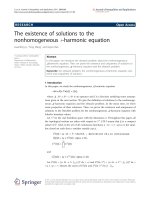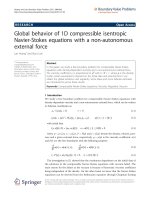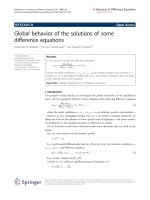Báo cáo hóa học: "ASYMPTOTIC BEHAVIOR OF SOLUTIONS FOR NEUTRAL DYNAMIC EQUATIONS ON TIME SCALES" pdf
Bạn đang xem bản rút gọn của tài liệu. Xem và tải ngay bản đầy đủ của tài liệu tại đây (526.75 KB, 11 trang )
ASYMPTOTIC BEHAVIOR OF SOLUTIONS FOR NEUTRAL
DYNAMIC EQUATIONS ON TIME SCALES
DOUGLAS R. ANDERSON
Received 30 January 2006; Rev ised 17 March 2006; Acce pted 17 March 2006
We investigate the boundedness and asymptotic behavior of a first-order neutral delay
dynamic equation on arbitrary time scales, extending some results from difference equa-
tions.
Copyright © 2006 Douglas R. Anderson. This is an open access article distributed under
the Creative Commons Attribution License, which permits unrestricted use, distribution,
and reproduction in any medium, provided the original work is properly cited.
1. Neutral delay dynamic equation
We consider, on arbitrary time scales, the neutral delay dynamic equation
x(t) − p(t)x
k(t)
Δ
+ q(t)x
(t)
=
0, t ∈
t
0
,∞
T
, (1.1)
where
T is a time scale unbounded above, the variable delays k, :[t
0
,∞)
T
→ T are
nondecreasing with k(t), (t) <tfor all t
∈ [t
0
,∞)
T
such that lim
t→∞
k(t), (t) =∞.The
coefficient functions p,q :
T → R are right-dense continuous with p bounded and q ≥ 0.
To clarify some notation, take
−1
(t):= sup{s : (s) ≤ t},
−(n+1)
(t) =
−1
(
−n
(t)) for t ∈
[(t
0
),∞)
T
,and
n+1
(t) = (
n
(t)) for t ∈ [
−3
(t
0
),∞)
T
.Forp and k above, let Ω be the
linear set of all functions given by
Ω :
=
x : T → R :
x(t) − p(t)x
k(t)
Δ
∈ C
rd
t
0
,∞
T
;R
; (1.2)
solutions of (1.1)willbelongtoΩ.
In the aftermath of Hilger’s breakthrough paper [4], a rapidly diversifying body of
literature has sought to unify, extend, and generalize ideas from discrete calculus, con-
tinuous calculus, and quantum calculus to arbitrary time-scale calculus, where a time
scale is merely a nonempty closed set of real numbers. This paper illustrates this new
understanding by extending some discrete results from difference equations to dynamic
equations on time scales. In particular, (1.1)isstudiedin[6]with
T
=
Z and p ≡ 0, and
in [5] in the case when
T
=
Z with variable p. Much of the organization of and moti-
vation for this paper arise from [5, 6].Formoreondelaydynamicequations,see,for
Hindawi Publishing Corporation
Advances in Difference Equations
Volume 2006, Ar ticle ID 80850, Pages 1–11
DOI 10.1155/ADE/2006/80850
2 Neutral dynamic equations
example, [1]; for more on time scales, jump ahead to the appendix, or consult the recent
texts [2, 3].
2. Vanishing of solutions at infinity
Recall that in this paper we consider only the case where the coefficient function p in
(1.1) is nonconstant but bounded. Before stating the main results, we need the following
lemma, which is a version of the integration-by-parts formula from continuous calcu-
lus, extended to arbitr ary time scales; note the interesting dependence on the graininess
function μ in the last term.
Lemma 2.1 (integration by par ts). For right-dense continuous functions q :
T → R and
points a,t
∈ T,
t
a
q(s)
σ(s)
a
q(z)Δz
Δs =
1
2
t
a
q(s)Δs
2
+
1
2
t
a
μ(s)q
2
(s)Δs. (2.1)
Proof. Let
Q(t):
=
1
2
t
a
q(s)Δs
2
+
1
2
t
a
μ(s)q
2
(s)Δs −
t
a
q(s)
σ(s)
a
q(z)Δz
Δs. (2.2)
Then Q(a)
= 0, and
Q
Δ
(t) =
1
2
q(t)
t
a
q(s)Δs −
σ(t)
a
q(s)Δs + μ(t)q(t)
. (2.3)
Since
σ(t)
a
=
t
a
+
σ(t)
t
and
σ(t)
t
q(s)Δs = μ(t)q(t) using [2, Theorem 1.75], Q
Δ
(t) ≡ 0. By
the uniqueness of solutions to initial value problems, Q(t)
≡ 0 and the conclusion follows.
For example, if T
=
R, then the graininess is zero and the simple formula is
t
a
q(s)
s
a
q(z)dz
ds =
1
2
t
a
q(s) ds
2
; (2.4)
when
T
=
Z,wehaveμ(t) ≡ 1and
t−1
k=a
k
j=a
q
k
q
j
=
1
2
t−1
k=a
q
k
2
+
1
2
t−1
k=a
q
2
k
. (2.5)
On a quantum time scale,
T
={
1,r,r
2
,r
3
, } for some r>1, so that the graininess is
increasing. Interpret the points a and t as r
a
and r
t
for positive integers a and t with t>a.
Then we have
t−1
k=a
k
j=a
r
k+ j
q
r
k
q
r
j
=
1
2
t−1
k=a
r
k
q
r
k
2
+
1
2
t−1
k=a
r
k
q
r
k
2
. (2.6)
Douglas R. Anderson 3
As a final example, we consider the time scale
T
={
k
n
=1
1/n : k ∈ N} of harmonic num-
bers, where the graininess is decreasing; the result may then be viewed as
t−1
k=a
k
j=a
1
(k +1)(j +1)
q
k
n=1
1
n
q
j
n=1
1
n
=
1
2
t−1
k=a
1
k +1
q
k
n=1
1
n
2
+
1
2
t−1
k=a
k +1
q
k
n=1
1
n
2
(2.7)
for positive integers a and t with t>a.
Theorem 2.2. Suppose there exists a constant
p ∈ (0,1/2] such that |p(t)|≤p for all t ∈ T,
and that for large t
∈ T,
0 <
p<
1
4
,
σ(t)
(t)
q(s)Δs ≤
3
2
− 2p (2.8)
or
1
2
≤ p ≤
1
2
,
σ(t)
(t)
q(s)Δs ≤
2(1 − 2p). (2.9)
Then every solution x
∈ Ω of (1.1)isbounded.
Proof. Find t
1
∈ T large enough, say t
1
>k
−1
(
−1
(t
0
)), such that
σ(t)
(t)
q(s)Δs ≤
⎧
⎪
⎪
⎨
⎪
⎪
⎩
A =
3
2
− 2p :0< p<
1
4
,
B
=
2(1 − 2p):
1
4
≤ p ≤
1
2
,
t
∈ [t
1
,∞)
T
. (2.10)
Suppose that, contrar y to the asserted conclusion, x is an unbounded solution of (1.1).
Set
z(t):
= x(t) − p(t)x
k(t)
, t ∈
t
0
,∞
T
. (2.11)
Then there exists t
∗
∈ (k
−1
(
−2
(t
1
)),∞)
T
large enough such that
x
t
∗
>
z
−2
t
1
2(1 − p)
,
x
t
∗
> sup
x(t)
: t ∈
t
0
,t
∗
T
. (2.12)
Then
z
t
∗
=
x
t
∗
−
p
t
∗
x
k
t
∗
> (1 − p)
x
t
∗
>
1
2
z
−2
t
1
. (2.13)
Without loss of generality, assume that z(t
∗
) > 0. Then by (2.13), there exist points T ∈
T
and t
†
∈ [(T),T)
T
such that
z(T)
= max
z(t):t ∈
−2
t
1
,t
∗
T
, z
Δ
t
†
> 0. (2.14)
4 Neutral dynamic equations
Set
y(t):
= z(t) − p
x
t
∗
for t ∈
t
1
,∞
T
. (2.15)
It follows that
x
(t)
=
z
(t)
+ p
(t)
x
k(t)
≥
z
(t)
−
p
x
t
∗
=
y
(t)
, t ∈
t
1
,T
T
(2.16)
(actually t
∈ [t
1
,k
−1
(
−1
(t
∗
))]
T
)sothat
y
Δ
(t) = z
Δ
(t) =−q(t)x
(t)
≤−
q(t)y
(t)
, t ∈
t
1
,T
T
, (2.17)
using (1.1), (2.11), and (2.13). Since
p ∈ (0,1/2],
y(T)
≥ z
t
∗
−
p
x
t
∗
> (1 − 2p)
x
t
∗
≥
0, (2.18)
but by the selection of t
†
,by(1.1), and (2.15),
0 <z
Δ
t
†
=−
q
t
†
x
t
†
≤−
q
t
†
y
t
†
, z
Δ
t
†
=
y
Δ
t
†
. (2.19)
Consequently y((t
†
)) < 0andy(T) > 0, so that by the intermediate value theorem [2,
Theorem 1.115], there exists t
2
∈ [(t
†
),T)
T
such that either y(t
2
) < 0 <y
σ
(t
2
)ory(t
2
) =
0. Either way, y(t
2
)y
σ
(t
2
) ≤ 0, hence there exists a real number ξ ∈ (0,1] such that
y
σ
t
2
−
ξ
y
σ
t
2
−
y
t
2
=
y
t
2
+(1− ξ)
y
σ
t
2
−
y
t
2
=
0. (2.20)
From (2.17), we have y
Δ
(s) ≤ q(s)|x(t
∗
)| for s ∈ [t
1
,T]
T
; integrating this from (t)tot
2
and using (2.20)andTheorem A.4,weobtainfort ∈ [t
2
,T)
T
that
−y
(t)
=
t
2
(t)
y
Δ
(s)Δs +(1− ξ)μ
t
2
y
Δ
t
2
≤
x
t
∗
σ(t
2
)
(t)
q(s)Δs − ξμ
t
2
q
t
2
.
(2.21)
Combine this with (2.17)toget
y
Δ
(t) ≤
x
t
∗
q(t)
σ
t
2
(t)
q(s)Δs − ξμ
t
2
q
t
2
, t ∈
t
2
,T
T
. (2.22)
In order to contradict (2.18), we now show that y(T)
≤ (1 − 2p)|x(t
∗
)| in the following
three cases.
Douglas R. Anderson 5
Case 1. Assume that 0 <
p<1/4and
T
σ(t
2
)
q(s)Δs + ξμ(t
2
)q(t
2
) ≤ 1. Then
y(T)
FTC
=
T
σ(t
2
)
y
Δ
(s)Δs + y
σ
t
2
(2.20)
=
T
σ(t
2
)
y
Δ
(s)Δs + ξμ
t
2
y
Δ
t
2
(2.22)
≤
x
t
∗
T
σ(t
2
)
q(s)
σ(t
2
)
(s)
q(z)Δz − ξμ
t
2
q
t
2
Δs
+ ξμ
t
2
q
t
2
σ(t
2
)
t
2
q(s)Δs − ξμ
t
2
q
t
2
.
(2.23)
By the property of delta integrals
b
a
+
c
b
=
c
a
,
y(T)
≤
x
t
∗
T
σ(t
2
)
q(s)
σ(s)
(s)
q(z)Δz −
σ(s)
σ(t
2
)
q(z)Δz − ξμ
t
2
q
t
2
Δs
+ ξμ
t
2
q
t
2
σ(t
2
)
(t
2
)
q(s)Δs − ξμ
t
2
q
t
2
.
(2.24)
Multiplying terms, rearranging them, then using (2.10)andLemma 2.1 yield
y(T)
≤
x
t
∗
A
T
σ(t
2
)
q(s)Δs −
1
2
T
σ(t
2
)
q(s)Δs
2
−
1
2
T
σ(t
2
)
μ(s)q
2
(s)Δs
+ ξμ
t
2
q
t
2
A −
T
σ(t
2
)
q(s)Δs − ξμ
t
2
q
t
2
=
x
t
∗
A
T
σ(t
2
)
q(s)Δs+ξμ
t
2
q
t
2
−
1
2
T
σ(t
2
)
q(s)Δs+ξμ
t
2
q
t
2
2
−
1
2
T
σ(t
2
)
μ(s)q
2
(s)Δs +
ξμ
t
2
q
t
2
2
≤
x
t
∗
⎛
⎝
A
T
σ(t
2
)
q(s)Δs+ξμ
t
2
q
t
2
−
1
2
T
σ(t
2
)
q(s)Δs+ξμ
t
2
q
t
2
2
⎞
⎠
.
(2.25)
Let w(z):
= Az − (1/2)z
2
,wherez =
T
σ(t
2
)
q(s)Δs + ξμ(t
2
)q(t
2
) ≤ 1. Then w
(1) > 0bythe
choice of A and the fact that in this case
p<1/4. As a result,
y(T)
≤
x
t
∗
A −
1
2
=
x
t
∗
(1 − 2p). (2.26)
6 Neutral dynamic equations
Case 2. Assume that 0 <
p<1/4and
T
σ(t
2
)
q(s)Δs + ξμ(t
2
)q(t
2
) > 1. Actually, from ξ ≤ 1,
we have in this case that
T
t
2
q(s)Δs>1. Note that
g(t):
=
T
t
q(s)Δs − 1, t ∈
t
2
,T
T
, (2.27)
isadelta-differentiable and decreasing function, so that g is continuous [2,Theorem
1.16(i)] on t
∈ [t
2
,T]
T
.Sinceg(t
2
) > 0andg(T) =−1 < 0, by the intermediate value the-
orem [2, Theorem 1.115], there exists t
3
∈ [t
2
,T)
T
such that either g(t
3
) = 0org(t
3
) >
0 >g
σ
(t
3
). Either way,
T
σ(t
3
)
q(s)Δs<1 ≤
T
t
3
q(s)Δs = μ
t
3
q
t
3
+
T
σ(t
3
)
q(s)Δs, (2.28)
therefore there exists a real number η
∈ (0,1] such that
T
σ(t
3
)
q(s)Δs + ημ
t
3
q
t
3
=
1. (2.29)
Recall from (2.17)that
y
Δ
(s) ≤ q(s)
x
t
∗
for s ∈
t
1
,T
T
; (2.30)
then
y(T)
(2.20)
=
T
σ(t
2
)
y
Δ
(s)Δs + ξμ
t
2
y
Δ
t
2
Theorem A.4
= ξμ
t
2
y
Δ
t
2
+
t
3
σ(t
2
)
y
Δ
(s)Δs +(1− η)μ
t
3
y
Δ
t
3
+ ημ
t
3
y
Δ
t
3
+
T
σ(t
3
)
y
Δ
(s)Δs
(2.22),(2.30)
≤
x
t
∗
ξμ
t
2
q
t
2
+
t
3
σ(t
2
)
q(s)Δs +(1− η)μ
t
3
q
t
3
+ ημ
t
3
q
t
3
σ(t
2
)
(t
3
)
q(s)Δs − ξμ
t
2
q
t
2
+
T
σ(t
3
)
q(s)
σ(t
2
)
(s)
q(z)Δz − ξμ
t
2
q
t
2
Δs
=
x
t
∗
1 ·
σ(t
3
)
σ(t
2
)
q(s)Δs − ημ
t
3
q
t
3
+
T
σ(t
3
)
q(s)
σ(t
2
)
(s)
q(z)Δz
Δs + ημ
t
3
q
t
3
σ(t
2
)
(t
3
)
q(s)Δs
.
(2.31)
Douglas R. Anderson 7
Replace the number 1 above using (2.29) and simplify to get
y(T)
≤
x
t
∗
T
σ(t
3
)
q(s)
σ(t
3
)
(s)
q(z)Δz − ημ
t
3
q
t
3
Δs
+ ημ
t
3
q
t
3
σ(t
3
)
(t
3
)
q(s)Δs − ημ
t
3
q
t
3
.
(2.32)
Use the fact that
σ(t
3
)
(s)
=
σ(s)
(s)
−
σ(s)
σ(t
3
)
and Lemma 2.1 to obtain
y(T)
≤
x
t
∗
A
T
σ(t
3
)
q(s)Δs + ημ
t
3
q
t
3
−
1
2
T
σ(t
3
)
q(s)Δs
2
−
1
2
T
σ(t
3
)
μ(s)q
2
(s)Δs − ημ
t
3
q
t
3
T
σ(t
3
)
q(s)Δs − (ημ
t
3
q
t
3
)
2
(2.29)
≤
x
t
∗
|
A −
1
2
(2.10)
≤
x
t
∗
(1 − 2p).
(2.33)
Case 3. As sume that 1/4
≤ p ≤ 1/2and
T
σ(t
2
)
q(s)Δs + ξμ(t
2
)q(t
2
) ≤ B for t ∈ T.Then,
starting as in Case 1,
y(T)
≤
x
t
∗
T
σ(t
2
)
q(s)
σ(t
2
)
(s)
q(z)Δz − ξμ
t
2
q
t
2
Δs
+ ξμ
t
2
q
t
2
σ(t
2
)
(t
2
)
q(s)Δs − ξμ
t
2
q
t
2
(2.10)
≤
x
t
∗
B
T
σ(t
2
)
q(s)Δs −
1
2
T
σ(t
2
)
q(s)Δs
2
−
1
2
T
σ(t
2
)
μ(s)q
2
(s)Δs
+ ξμ
t
2
q
t
2
B −
T
σ(t
2
)
q(s)Δs − ξμ
t
2
q
t
2
≤
x
t
∗
B
T
σ(t
2
)
q(s)Δs + ξμ
t
2
q
t
2
−
1
2
T
σ(t
2
)
q(s)Δs + ξμ
t
2
q
t
2
2
≤
x
t
∗
B
2
2
= (1 − 2p)
x
t
∗
.
(2.34)
8 Neutral dynamic equations
As all three cases lead to the same contradiction, solutions x
∈ Ω of (1.1)mustbe
bounded.
Theorem 2.3. Suppose there exists a constant p ∈ [0,1/2) such that |p(t)|≤p for all t ∈ T,
and
∞
t
0
q(s)Δs =∞. (2.35)
If
0
≤ p<
1
4
,limsup
t→∞
σ(t)
(t)
q(s)Δs ≤
3
2
− 2p (2.36)
or
1
4
≤ p<
1
2
,limsup
t→∞
σ(t)
(t)
q(s)Δs ≤
2(1 − 2p), (2.37)
then every solution x
∈ Ω of (1.1)goestozeroast →∞.
Proof. Let x
∈ Ω be a solution of (1.1). If x is nonoscillatory, assume that x is eventually
positive. Again select z as in (2.11); then z is eventually nonincreasing using (1.1). If
z := lim
t→∞
z(t), then z is bounded by Theorem 2.2 and
limsup
t→∞
x(t) = z +limsup
t→∞
p(t)x
k(t)
≤
z + p limsup
t→∞
x(t), (2.38)
so that
0
≤ limsup
t→∞
x(t) ≤
z
1 − p
=⇒ z ≥ 0. (2.39)
But from (1.1), we have
∞
t
0
q(t)x
(t)
Δt = z
t
0
−
z<∞, (2.40)
which in view of (2.35) means that
0
= liminf
t→∞
x(t) = z + lim inf
t→∞
p(t)x
k(t)
≥
z − p limsup
t→∞
x(t) ≥
1 − 2p
1 − p
z ≥ 0. (2.41)
Thus
z = 0andlim
t→∞
x(t) = 0.
If x is oscillatory, by Theorem 2.2 x is also bounded. Set
x := limsup
t→∞
|x(t)|.Then
0
≤ x<∞ and z = limsup
t→∞
|z(t)|≥(1 − p)x; without loss of generality, assume that
z := limsup
t→∞
z(t) ≥ (1 − p)x. (2.42)
Douglas R. Anderson 9
If
x>0, then for any
∈
(0,(1 − 2p)x), there exist constants A ∈ (0, 3/2 − 2p)andB ∈
(0,
2(1 − 2p)) and T ∈ T such that |x(t)| < x + for t ∈ (k
−1
(
−1
(T)),∞)
T
and
σ(t)
(t)
q(s)Δs ≤
⎧
⎪
⎪
⎨
⎪
⎪
⎩
A :0< p<
1
4
,
B :
1
4
≤ p<
1
2
,
t ∈ [T,∞)
T
. (2.43)
If
y(t):
= z(t) − (x +)p for t ≥ (T), (2.44)
then
−x
(t)
=−
z
(t)
−
p
(t)
x
k
(t)
≤−
z
(t)
+(x + )p =−y
(t)
, t ≥ T.
(2.45)
Using (1.1)and(2.44), we have
y
Δ
(t) = z
Δ
(t) =−q(t)x
(t)
≤−
q(t)y
(t)
, t ≥ T. (2.46)
Since z
Δ
is oscillatory, y
Δ
is too, so there exists an increasing sequence {t
n
∈ T} such
that t
n
>k
−1
(
−2
(T)), lim
n→∞
t
n
=∞, y(σ(t
n
)) → z − (x + )p>0asn →∞by (2.42)and
(2.46), and y
Δ
(t
n
) ≥ 0. Consequently, 0 ≤ y
Δ
(t
n
) ≤−q(t
n
)y((t
n
)) so that
y
t
n
≤
0, y
σ
(t
n
) > 0, n ∈ N. (2.47)
Hence there exists t
†
∈ [(t
n
),t
n
]
T
such that either y(t
†
) < 0 <y
σ
(t
†
)ory(t
†
) = 0. Either
way, y(t
†
)y
σ
(t
†
) ≤ 0, and there exists a real number ξ ∈ (0,1] such that
y
σ
t
†
−
ξ
y
σ
t
†
−
y
t
†
=
y
t
†
+(1− ξ)
y
σ
t
†
−
y
t
†
=
0. (2.48)
From (2.46), we have
y
Δ
(t) ≤−q(t)y
(t)
≤
q(t)(x + ), t ∈
T,t
n
T
, (2.49)
which combined with the fundamental theorem and (2.48)yieldsfort
∈ [t
†
,t
n
]
T
that
−y
(t)
=
t
†
(t)
y
Δ
(s)Δs +(1− ξ)μ
t
†
y
Δ
t
†
≤
(x + )
σ(t
†
)
(t)
q(s)Δs − ξμ
t
†
q
t
†
.
(2.50)
Put this into (2.46)toobtain
y
Δ
(t) ≤ (x + )q(t)
σ(t
†
)
(t)
q(s)Δs − ξμ
t
†
q
t
†
, t ∈
t
†
,t
n
T
. (2.51)
10 Neutral dynamic equations
Set
λ
=
⎧
⎪
⎪
⎨
⎪
⎪
⎩
max
A −
1
2
,
1
2
:0≤ p<
1
4
,
B
2
2
:
1
4
≤ p<
1
2
;
(2.52)
then λ<1
− 2p. Notice that by replacing |x(t
∗
)| by x + in the proof of Theorem 2.2,we
arrive at y(t
n
) ≤ λ(x + ). But then by (2.44), z(t
n
) ≤ (x + )(λ + p). Letting n →∞and
→
0 results in
z = limsup
n→∞
z(t
n
) ≤ (λ + p)x<(1 − p)x, (2.53)
a contradiction of (2.42). Therefore
x = limsup
t→∞
|x(t)|=0, so that any solution x ∈ Ω
of (1.1)goestozero.
Appendix
A. Time scales
The definitions below merely serve as a preliminary introduction to the time-scale calcu-
lus; they can be found in the context of a much more robust t reatment than is allowed
here in the texts [2, 3] and the references therein.
Definit ion A.1. Define the forward (backward) jump operator σ(t)att for t<sup
T (resp.,
ρ(t)att for t>inf
T)by
σ(t)
= inf{τ>t: τ ∈ T},
ρ(t) = sup{τ<t: τ ∈ T}
, ∀t ∈ T. (A.1)
Also define σ(sup
T) = supT if supT < ∞,andρ(inf T) = inf T if inf T > −∞. Define the
graininess function μ :
T → R by μ(t) = σ(t) − t.
Throughout this work, the assumption is made that
T is unbounded above and has the
topology that it inherits from the standard topology on the real numbers
R.Alsoassume
throughout that a<bare points in
T and define the time scale interval [a,b]
T
={t ∈
T
: a ≤ t ≤ b}.Thejumpoperatorsσ and ρ allow the classification of points in a time
scale in the following way. If σ(t) >t, the point t is right-scattered, while if ρ(t) <tthen
t is left-scattered. If σ(t)
= t, the point t is right-dense; if t>inf T and ρ(t) = t,thent is
left-dense.
Definit ion A.2. Fix t
∈ T and let y : T → R.Definey
Δ
(t) to be the number (if it exists)
with the property that given that
> 0, there is a neighbourhood U of t such that for all
s
∈ U,
y
σ(t)
−
y(s)
−
y
Δ
(t)
σ(t) − s
≤
σ(t) − s
. (A.2)
Call y
Δ
(t) the (delta) derivative of y at t.
Douglas R. Anderson 11
Definit ion A.3. If F
Δ
(t) = f (t), then define the (Cauchy) delta integral by
t
a
f (s)Δs = F(t) − F(a). (A.3)
The following theorem is due to Hilger [6].
Theorem A.4. Assume that f :
T → R and let t ∈ T.
(1) If f is differentiable at t, then f is continuous at t.
(2) If f is continuous at t and t is right-scattered, then f is differentiable at t with
f
Δ
(t) =
f
σ(t)
−
f (t)
σ(t) − t
. (A.4)
(3) If f is differentiable and t is right-dense, then
f
Δ
(t) = lim
s→t
f (t) − f (s)
t − s
. (A.5)
(4) If f is differentiable at t, then f (σ(t))
= f (t)+μ(t) f
Δ
(t).
Definit ion A.5. A function f :
T → R is right-dense continuous (denoted by f ∈C
rd
(T;R))
provided that f is continuous at ever y right-dense point t
∈ T,andlim
s→t
−
f (s)existsand
is finite at every left-dense point t
∈ T.
According to [2, Theorem 1.74], ever y right-dense continuous function has a delta
antiderivative. This implies that the delta definite integral of any right-dense continuous
function exists.
References
[1] D. R. Anderson, R. J. Krueger, and A. C. Peterson, Delay dynamic equations with stability,Ad-
vances in Difference Equations 2006 (2006), Article ID 94051, 19 pages.
[2] L. Berezansky and E. Braverman, Oscillationofalogisticdifference equation with several delays,
Advances in Difference Equations 2006 (2006), Article ID 82143, 12 pages.
[3] M. Bohner and A. C. Peterson, Dynamic Equations on Time Scales, An Introduction with Appli-
cations,Birkh
¨
auser, Massachusetts, 2001.
[4] M. Bohner and A. C. Peterson (eds.), Advances in Dynamic Equations on Time Scales,Birkh
¨
auser,
Massachusetts, 2003.
[5] L.H.Erbe,H.Xia,andJ.S.Yu,Global stability of a linear nonautonomous delay difference equa-
tion,JournalofDifference Equations and Applications 1 (1995), no. 2, 151–161.
[6] S. Hilger, Analysis on measure chains—a unified approach to continuous and discrete calculus,
Results in Mathematics 18 (1990), no. 1-2, 18–56.
Douglas R. Anderson: Department of Mathematics and Computer Science, Concordia College,
Moorhead, MN 56562, USA
E-mail address:









